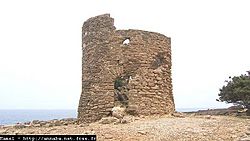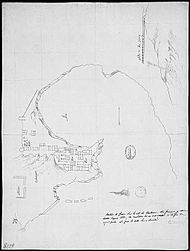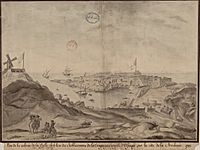Bastion de France facts for kids

The Bastion de France was an important trading post built in the 1500s. It was set up by French merchants from Corsica who settled in North Africa, near a city called Annaba. This place became a key link for trade with Marseille, especially for valuable coral. Over time, the Bastion was destroyed and rebuilt many times.
Contents
Who Built the Bastion de France?
The Bastion de France was built in 1561 by a man named Tomasino Lenche. He wanted to protect his family's very profitable business of fishing for coral off the coast of North Africa.
The Lenche family came from a place called Morsiglia in Cap Corse. Tomasino Lenche had already started a successful business in Marseille by 1533. In 1550, the ruler Sultan Selim II gave him permission to fish for coral near Annaba. The next year, the French king Henri II of France gave him a special right to be the only one allowed to fish for coral there. This special right was renewed in 1560 by King Charles IX.
In 1552, Tomasino started a company called the Magnificent Coral Company. He worked with his nephews, Visconte and Antonio Lenche, and his cousins. Their business grew very fast! Soon, about 250 fishermen were working on 50 boats. Coral was very valuable. Fishermen were paid a small amount for a pound of coral, but it could be sold for much more. Coral was a luxury item used in jewelry, like making rosaries. It was also used as money in places like Alexandria.
Antonio Lenche Takes Over
In 1568, the city of Algiers took control of the Bastion. But the Lenche family quickly got it back. Tomasino's nephew, Antonio Lenche, became the governor of the Bastion de France from 1568 to 1588. He was one of the richest men in Marseille.
During Antonio's time, King Henri III confirmed that the Magnificent Coral Company still had its special trading rights. He also expanded their fishing areas to include places like Bizerte. Antonio's cousin, Orso-Santo Cipriani, started another coral company. This meant that the Lenche family's companies controlled almost all the coral trade along the North African coast.
However, their business got caught up in big conflicts in France, known as the French Wars of Religion. The Lenche family supported King Henri III, while another group, the Catholic League, was against him. Antonio Lenche was killed in 1588 by people who supported the Catholic League.
Thomas II Lenche and Challenges
Antonio's son, Thomas, became governor of the Bastion in 1597. But the Lenche family's success was threatened by conflicts in North Africa. In June 1604, the Bastion de France was destroyed by soldiers from Annaba, helped by ships from Algiers.
The Lenches asked King Henri IV for help. The king protested through his representative in Algiers. The representative was treated badly, but eventually, Thomas was able to get his trading rights back.
In 1602, Charles of Lorraine visited the Bastion de France for King Henri IV. This visit showed that France had a presence there. But in 1604, after more arguments, the Bastion was again taken over and destroyed. France was powerful enough to make sure the ruler of Algiers was removed from power for this attack. In 1608, Algiers made a new deal that favored merchants from Bordeaux. Bordeaux wanted to take over Marseille's leading role in luxury trade and push the Lenche family out.
Another attack from Algiers happened in 1615–1616. In 1616, Captain Jacques Vinciguerra tried to rebuild the Bastion de France. A period of peace began in 1617. A man named Jean-Louis du Mas de Castellane was sent by the Ottoman Sultan to arrange for the Bastion to be returned to the French. But while he was in Algiers, fighting started again, and he was captured. He was only released in 1619.
By 1619, Thomas II Lenche was tired of the constant destruction. He sold his rights to the Bastion to the duc de Guise, who was the governor of Provence. In return, Thomas received a yearly payment.
Sanson Napollon and Royal Control
In the late 1620s, relations between France and Algiers finally became normal. On September 19, 1628, Sanson Napollon, a cousin of the Lenches, signed a treaty. This treaty allowed merchant ships to travel safely again. King Louis XIII paid a large amount of money to free European captives and cover other costs. Napollon took control of the trading posts at Annaba, La Calle (El Kala), and the Bastion de France. Besides restarting the coral fishing, Sanson Napollon also opened a new base to trade wheat.
In 1631, King Louis named Sanson Napollon as governor of the Bastion de France. The Bastion now belonged to the French king, not to the duc de Guise. However, in 1633, Sanson Napollon was killed in an attack. In 1637, a new attack from Algiers badly damaged the French trading posts. The buildings of Bastion de France, El Kala, and Cap Rosa were destroyed. But an agreement in 1640 allowed them to be rebuilt.
For 50 years, the Bastion remained in ruins. In 1684, after a naval attack on Algiers, the ruler of Algiers signed a new peace treaty. For 100 years, France was given control of the Bastion de France, La Calle, Cap Rosa, Annaba, Béjaïa, and other places. A treaty in 1689 gave the Bastion and the right to trade there to the Hély Company.
See also
- Tabarka
- European enclaves in North Africa before 1830
- History of the Mediterranean region
- List of cultural assets of Algeria



